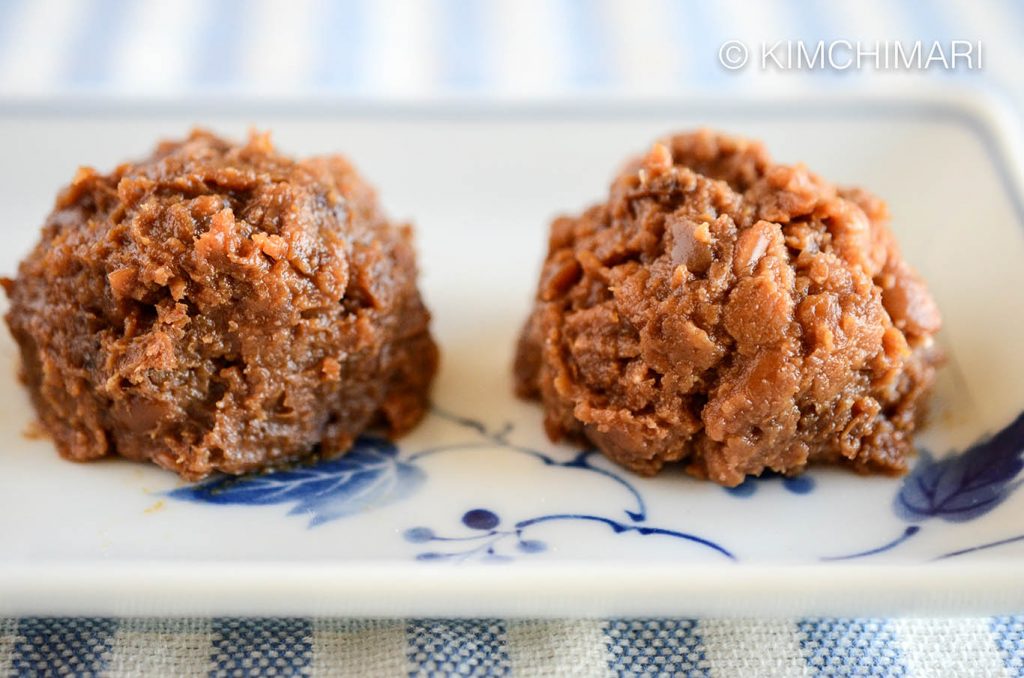
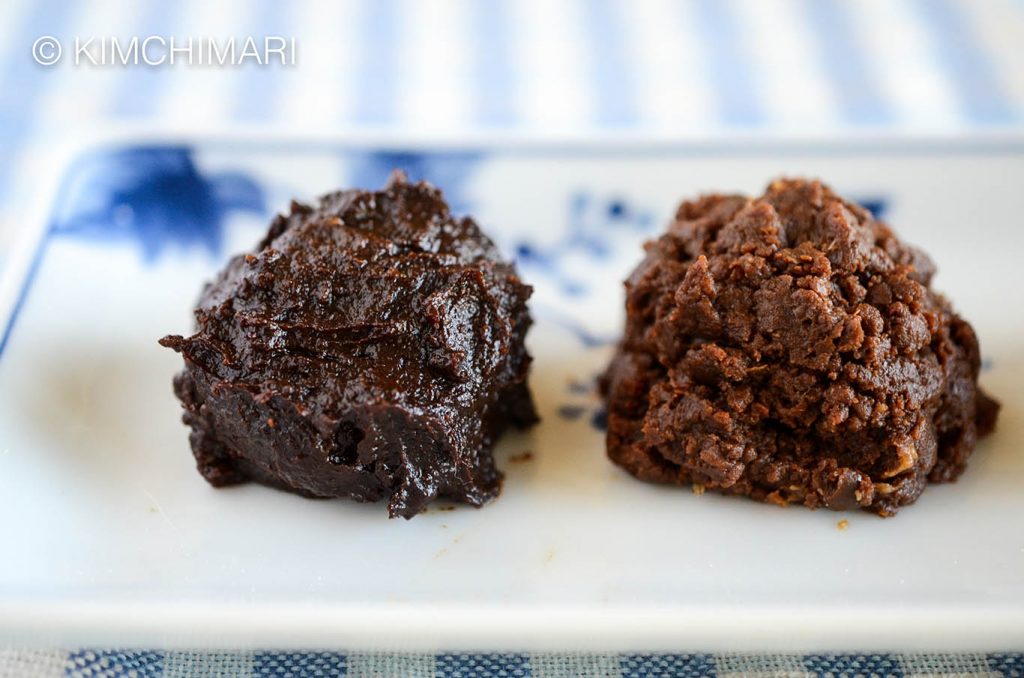
What is Doenjang?
Doenjang (Korean Soybean Paste – pronounced DEN-jahng) is a twin sister to Gochujang that is not spicy and lot more complex in flavor. Probably much less known than Gochujang outside of Korea. But in my opinion, it is one of the most amazing seasoning ingredient in Korean cuisine. Doenjang (된장) is fermented Korean soybean paste that is made by fermenting cooked soybeans with salt for 6 months or more.
Making doenjang requires a lot more work and time than gochujang but you also get a huge depth of umami flavor in return. It also tastes a little sour and salty in addition to its amazing umami flavor.
What is the difference between Korean Doenjang vs Japanese Miso?
They are both made from fermented soybeans and salt. But they have different colors, different ingredients and different flavors. Traditional Korean doenjang is made just from soybeans and salt only. Miso usually is made by adding koji starter to rice in addition to soybeans which produces a sweeter taste. In terms of flavor, I would say the difference in flavor is like comparing American Cheese and blue cheese or parmesan cheese. Miso is milder, smoother and sweeter. Korean Doenjang is stronger, sharper, deeper and more complex in its flavor profile. I am not saying one is better than the other (I love miso too!) they are just different in flavors and their place in cooking.
What do the different names of Doenjang mean on the labels?
I know many who can’t read Korean are probably frustrated that it is hard to tell what the difference is among all the different kinds just by reading their English names. I just came back from a Korean grocery store and realized that the English descriptions are quite confusing and there’s absolutely no consistency. Sorry about this folks…
Categories of Doenjang (Korean SoyBean Pastes)
“Seasoned Deonjang” – this is one word that seems to be somewhat consistently used. But in fact, it can actually be one of two things.
- Ssamjang (쌈장) – for lettuce wraps (sssam) with BBQ meats. It is made by mixing gochujang with Doenjang and aromatics. My recipe here.
- Yangnyeom Doenjang (양념된장) – for stews/jjigae with added flavor enhancers such as onion, garlic, kelp, mushrooms and/or dried anchovies. Good to have if you want to make your jjigae quickly without the fuss. But beware that some may have MSG. There are some good ones that you can buy without MSG which you can use for stews. My favorite brand to buy in US is Yangpyeong Gang Doenjang (양평강된장). But if you have a good basic doenjang, then you won’t need this.
“Classic/Traditional/Original Doenjang” – this is usually one of two kinds. Doenjang made using more modern fast factory methods (Gyerang-sik 개량식) and then the Traditional (Jaerae-sik 재래식) made using slow traditional methods.
More formally, Korean soybean pastes can be divided into three major groups based on the process. *This is purely my categorization. As you can tell, this took some research and thinking on my part.
- Traditional slow methods (6 months+) : Jaerae (재래)/Jaeraesik (재래식)/ Jeontong (전통)/Jip (집) + Doenjang (된장): These soybean pastes are made by first allowing meju blocks to ferment in brine for couple months to produce a black liquid which we is Korean Gukganjang soy sauce. The soy sauce liquid is then drained away and the remaining dark brown meju solids are mixed with salt and chili powder. This mixture is left to ferment for another 2 -3 months (minimum). This is the classic/traditional kind that our moms made every year and every household had this as the most basic Korean soybean paste.
- FYI, ‘Jip’ = ‘house‘ and ‘Jaerae’ =’Jeontong’ = ‘traditional’ and ‘Jaeraesik’ = ‘traditional style’. So look for these words. Also called Hansik Doenjang sometimes.
- Traditional fast methods (1-2 months+): Tojang (토장) : Meju blocks are first crushed and then salt is added directly and left to ferment. This skips the step of fermenting in brine and thus the production of soy sauce which shortens the time and is also known to have more flavor since nothing is taken away. There are many local variations to this group of doenjang (Makjang 막장, Jeupjang 즙장..) where different ingredients such as barley, garlic, rice are added for flavor.
- Modern factory methods: Gyerangsik Doenjang(개량식된장) : Instead of allowing soybeans to ferment naturally, a koji starter is first grown in starches like rice, barely or wheat. Koji is then mixed with cooked soybeans and salt and left to ferment. Then ground up for smoothness. This style of fermentation process produces more sugars and so you end up with a sweeter, smoother tasting doenjang. Most commercial doenjang belongs to this category unless it is explicitly stated as ‘Jarae/Jaraesik’ or otherwise.
Here is a sample variety that I grabbed out of my fridge – some lighter, some darker.
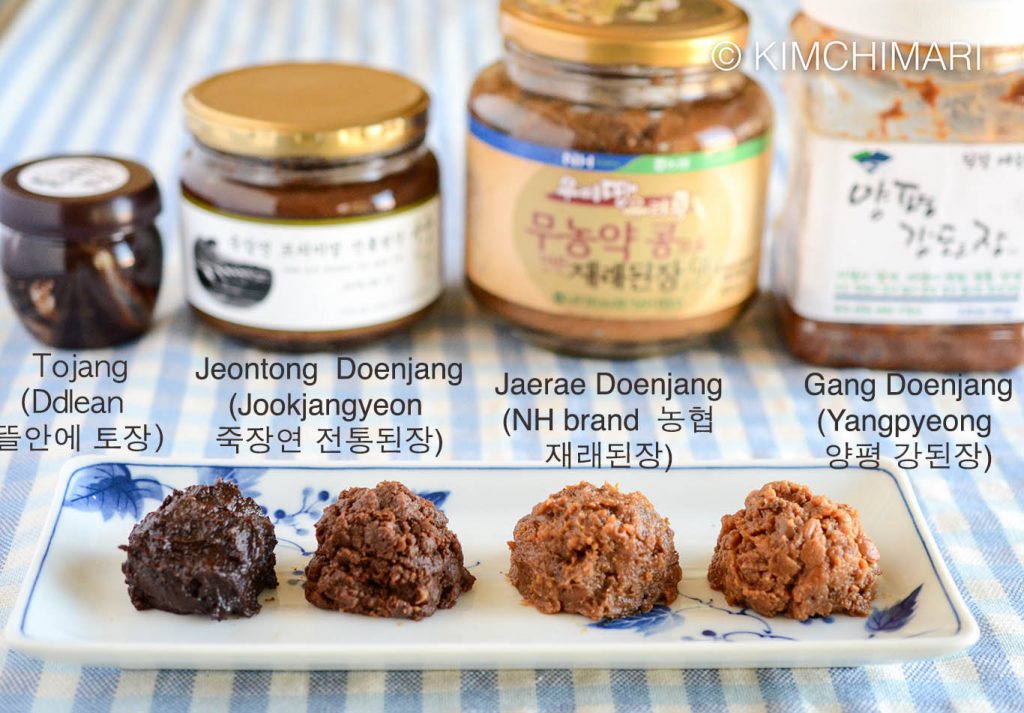
Why do Doenjang have different colors? Why do they become black?
Doenjang becomes black when it is exposed to oxygen. Generally, the longer the fermentation, the darker the color. But sometimes it is also due to ingredients used. The top layer always become black but when you turn it over and mix the black part back in, the color will change back to brown because it is no longer exposed to air. So it is perfectly fine to eat Doenjang that has become darker. Traditional Jarae Doenjang with proper amount of salt will never go bad. It can, however, become too dry in which case it is not the best tasting.
If you see in my picture above, there are 4 different kinds – of different colors and age:
Left to Right:
- Tojang by Ddlean (뜰안에 된장) – This is the doenjang I made in a class in Korea in 2015. It is the one made by skipping the soy sauce process and also adding barley. (Method 2) Soybean, barley, salt, chili powder.
- Jeonteong Doenjang by Jookjangyeon (죽장연)– Chef Hooni Kim uses this doenjang in his michelin star Hanjan restaurant in NY. The one I have was made in 2012 so it is now in it’s 4th year. Wonderfully deep in flavor, also more condense and saltier than more common store brands. (Method 1). Soybean 96%, Salt 4% – GF
- Jaerae Doenjang by NongHyup (농협) – NongHyup is Korea’s National Agricultural Cooperative Federation and their brands NH are available now in some large Korean grocery stores in the US. (Method 1). Soybean, Wheat, Salt
- Gang Doenjang by Yangpyeong (양평) – This is a seasoned doenjang that I buy from my local store. Soybean, wheat, salt, garlic, onion, ginger, chili powder, green onions, green peppers, dried anchovy, dried kelp. Great of Jjigae!
What should I look for when buying Doenjang?
I know the chances of you making this wonderful seasoning paste will be pretty slim. Even I have not yet attempted that but someday.. someday… So then this is probably the question that most of you have.
Traditional ingredients will have:
- Soybeans
- Korean Solar Sea Salt (천일염 Cheonil yeom)
- Water
- Dried chili peppers (these are removed with liquid soy sauce)
- Dried Jujubes (these are removed with liquid soy sauce)
Your store bought Doenjang will probably have at least:
- Soybeans (대두 Daedu)
- Salt (소금) or Solar Sea Salt (천일염 Cheonil yeom)
- Water or Purified Water (정제수 Jungjaesu)
- Extracted Alcohol (주정 Jujeong)
And if it’s made using Factory Method, it will likely will have following:
- Koji starter (종국 Jonguk) – Koji fungus is a species of molds classified under the Aspergillus genus.
- Wheat (소두 Sodu) or some other Grain – avoid this if you want gluten free
If made traditionally using method 1, it should be gluten free. So basically, the most authentic, traditional soybean pastes are gluten free.
Best Classic Unseasoned Doenjang to buy?
Both Jookjangyeon and NH brand’s are some of the best authentic tasting pastes with the most complex umami flavors. But these are not very easily available in the US. So during my recent trip to the store, I looked through a lot of soybean pastes and found these two to have the best set of authentic ingredients and good flavor.
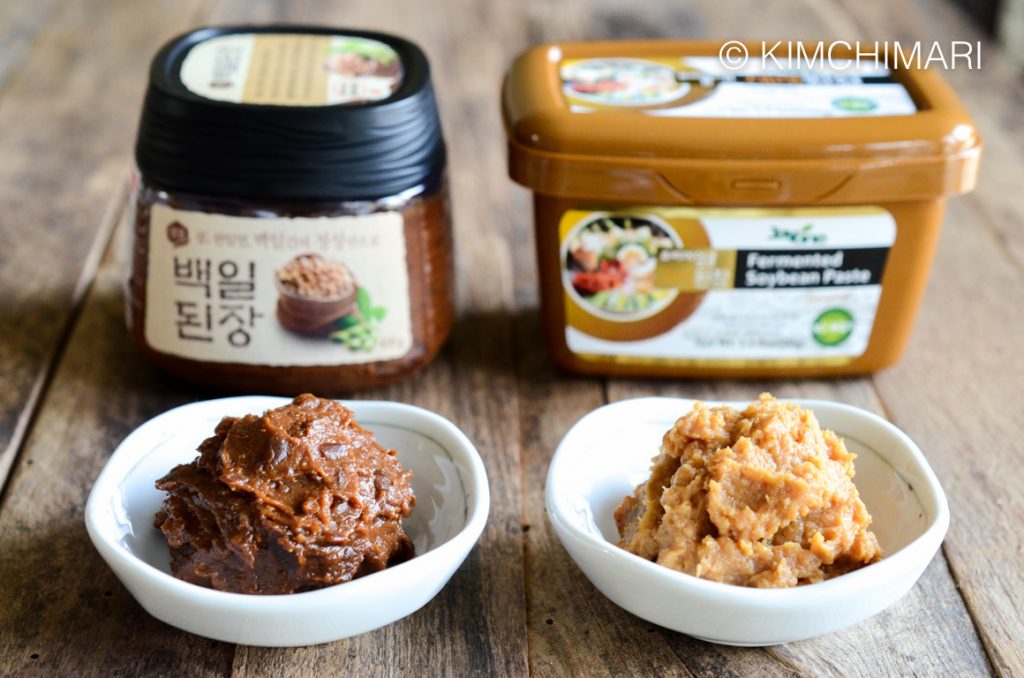
LEFT: Baekil Doenjang (백일된장) = ‘100 days soybean paste’ by Sempio. Sempio has been making Ganjang and Doenjang for over 70 years and so they know something about making them. 🙂 No.. I am not paid to say this. I wish!! hahaha..They recently came out with this new product where they say they have fermented the soybeans for 100 days using the traditional slow method. It has great deep umami flavor and is made with just 5 ingredients: water, soybean, salt, alcohol, koji starter. I’m so happy they have this and it’s Gluten Free~!
RIGHT: Jaerae Doenjang by Jayone. Jayone is relatively new to this area and I was happy to see this even in our local regular grocery store. No specific details could be found but the word Jaerae and the ingredients list seem to point to more traditionally made paste. Ingredients: Non GMO Soybean powder, Non GMO Soybean, Wheat flour, water, salt, alcohol. As you can tell from the color, this is a much younger paste with a simpler and smoother taste that’s similar to miso but you may like this better if you are not used to the real strong taste of the authentic kind.
More Pre-Seasoned Doenjang for Stews (updated 5/30/2020)
If you make a lot of stews or soups, I’ve found these pastes in recently that are also great to have because it already has a lot of flavors added. ALLERGEN NOTE – these may contain wheat, fish, shellfish or flavor enhancers.

LEFT: Sempio Tojang (토장) – although the name Tojang is used to refer to soybean pastes made using the Classic Fast method (#2 method of 1 to 2 month fermentation), this one by Sempio comes pre-seasoned with seafood seasoning, cuttlefish powder, kelp extract, sugar, onion, garlic and more.
RIGHT: CJ’s Dadam (다담) – this one has become very popular among Koreans recently and has Kelp, Anchovy, Clam extracts, corn syrup, sugar, egg, milk, crab, shrimp and flavor enhancers. If you don’t mind some flavor enhancers, this one does instantly make your stew taste so much better. I don’t use it often but sometimes if I’m lazy or don’t have good stock ingredients, I will use it.
What are the health benefits of Doenjang?
Korean fermented soybean paste has been found to have great health benefits such as anticancer, antimetastatic, and antigenotoxic effects. Here are some actual research:
- Longer fermentation of Doenjang improves its anticancer, antimetastatic properties.
- Research that shows Antigenotoxic effects of Korean fermented soybean paste. FYI, antigenotoxic means it counters genotoxicity which “describes the property of chemical agents that damages the genetic information within a cell causing mutations, which may lead to cancer.” (Wikipedia)
However, due to the high salt content, one should be careful about consuming large amounts of it.
Well, whew – that was a lot of work but hopefully it was worth it! And hope you make some wonderful Doenjang Jjigae this weekend!
XOXO
JinJoo
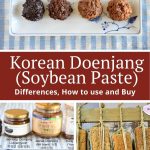
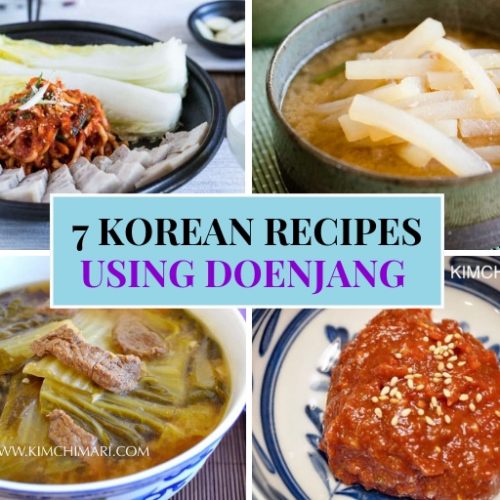

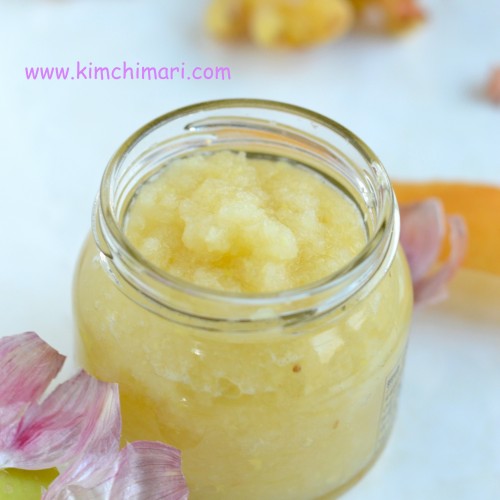

















Looking for bean paste that have has the most pungent smell . My bean paste that I bought from supermarket are not smelly at all .
Very helpful, thank you taking the time to explain 🙂
You are so welcome! Thank you so much for taking the time to comment.
How do I use the Sempio Tojang since it is pre seasoned?
Use Tojang in stews (jjigae) mostly but you can also add them to soups but probably mix it with plain Doenjang. Cheers!
what about Wangshin brand? It is sold on Amazon and says it is aged 2 years. Any good?
Hi Larry, I’m sorry but I have no experience with this product. It sounds good – I would look at the ingredient list. If it has just soy beans, salt and not much else – maybe anchovy powder in this case – I would say it’s a good product. Sorry I can’t help more.